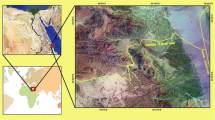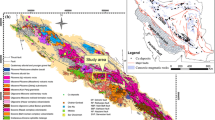Abstract
This study is an attempt to understand the application of spectral image processing methods to ASTER data for mapping host rock associated with porphyry copper-molybdenum mineralization. The application of remote sensing in identifying variations in surface mineralogy, structural elements, and lithologic contacts can help in identifying such relations. Signatures collected from the Advanced Spaceborne Thermal Emission Reflection Radiometer (ASTER) data is used to map the host rock of Zafarqand area. The study area is located in the central segment of the Urumieh–Dokhtar volcanic belt of Iran. The Urumieh-Dokhtar is a potential zone for exploration of new porphyry copper deposits. Band ratio, band math, false colour composites and principal component analysis techniques are used to refine the different lithologic units in the area. These methods showed the discrimination of acidic igneous rock from intermediate igneous rock and the boundary between igneous rocks using the shortwave infrared bands (SWIR) of ASTER at regional scale. Results have proven to be effective and in accordance with the results of field observations, ore microscopy examination and with reference geological map. In conclusion, the image processing methods used can provide cost-effective information to discover possible locations of porphyry copper and epithermal gold mineralization prior to detailed and costly ground investigations. The extraction of spectral information from ASTER data can produce comprehensive and accurate information for copper and gold resource investigations around the world, including those yet to be discovered.
Similar content being viewed by others
References
Abdeen, M. M., Allison, T. K., Abdelsalam, M. G., & Stern, R. J. (2001). Application of ASTER bandratio images for geological mapping in arid regions; the Neoproterozoic Allaqi Suture, Egypt. Geol. Soc. Amer. Abstr, Programs, v.3(3), p.289.
Aboelkhair, H., Ninomiya, Y., Watanabe, Y. and Sato, I. (2010) Processing and interpretation of ASTER TIR data for mapping of rare-metal-enriched albite granitoids in the Central Eastern Desert of Egypt. Jour. African Earth Sci., v.58(1), pp.141–151.
Abrams, M., Hook, S. and Ramachandran, B. (2002) ASTER User Handbook. second ed. JPL PublicationLaboratory, California Inst. Tech., 135p.
Alimohammadi, M., Alirezaei, S. and Kontak, D. J. (2015) Application of ASTER data for exploration of porphyry copper deposits: A case study of Daraloo–Sarmeshk area, southern part of the Kerman copper belt, Iran. Ore Geol. Rev., v.70, pp.290–304.
Amer, R., El Mezayen, A. and Hasanein, M. (2016) ASTER spectral analysis for alteration minerals associated with gold mineralization. Ore Geol. Rev., v.75, pp.239–251.
Amer, R., Kusky, T. and El Mezayen, A. (2012) Remote sensing detection of gold related alteration zones in Um Rus area, Central Eastern Desert of Egypt. Advances in Space Research, v.49(1), pp.121–134.
Amer, R., Kusky, T. and Ghulam, A. (2010) Lithological mapping in the Central Eastern Desert of Egypt using ASTER data. Jour. African Earth Sci., v.56(2), pp.75–82.
Austin, S.A. (1996) Excess argon within mineral concentrates from the new dacite lava dome at Mount St. Helens volcano. Creation Ex Nihilo Technical Jour., v.10(3), pp.335–343.
Azizi, H., Tarverdi, M. and Akbarpour, A. (2010) Extraction of hydrothermal alterations from ASTER SWIR data from east Zanjan, northern Iran. Advances in Space Research, v.46(1), pp.99–109.
Bachmann, O. and Bergantz, G. W. (2004) On the origin of crystal-poor rhyolites: extracted from batholithic crystal mushes. Jour. Petrol., v.45(8), pp.1565–1582.
Bedell, R. (2001) Geological mapping with ASTER satellite: new global satellite data that is a significant leap in remote sensing geologic and alteration mapping. Spec. Publ. Geol. Soc. Nevada, v.33, pp.329–334.
Bedini, E. (2011) Mineral mapping in the Kap Simpson complex, central East Greenland, using HyMap and ASTER remote sensing data. Advances in Space Res., v.47(1), pp.60–73.
Clark, R. N., King, T. V., Klejwa, M., Swayze, G. A. and Vergo, N. (1990). High spectral resolution reflectance spectroscopy of minerals. Jour. Geophys. Res., Solid Earth, v.95(B8), pp.12653–12680.
Crosta, A., De Souza Filho, C., Azevedo, F. and Brodie, C. (2003) Targeting key alteration minerals in epithermal deposits in Patagonia, Argentina, using ASTER imagery and principal component analysis. international Jour. Remote Sensing, v.24(21), pp.4233–4240.
Cudahy, T., Jones, M., Thomas, M., Laukamp, C., Caccetta, M., Hewson, R.,... Verrall, M. (2008) Next generation mineral mapping: Queensland airborne HyMap and satellite ASTER surveys 2006–2008. CSIRO Exploration & Mining Report, P2007/2364.
Di Tommaso, I. and Rubinstein, N. (2007) Hydrothermal alteration mapping using ASTER data in the Infiernillo porphyry deposit, Argentina. Ore Geol. Rev., v.32(1), pp.275–290.
Gabr, S., Ghulam, A. and Kusky, T. (2010) Detecting areas of high-potential gold mineralization using ASTER data. Ore Geol. Rev., v.38(1), pp.59–69.
Gupta, R. P. (2003) Remote Sensing Geology. second ed. Springer, Heidelberg.
Hezarkhani, A. (2006) Hydrothermal evolution of the Sar-Cheshmeh porphyry Cu–Mo deposit, Iran: Evidence from fluid inclusions. Jour. Asian Earth Sci., v.28, pp.409–422.
Hunt, G. R. (1977) Spectral signatures of particulate minerals in the visible and near infrared. Geophysics, v.42(3), pp.501–513.
Hunt, G. R. and Ashley, R. P. (1979) Spectra of altered rocks in the visible and near infrared. Econ. Geol., v.74(7), pp.1613–1629.
Ibrahim, W.S., Watanabe, K. and Yonezu, K. (2016) Structural and lithotectonic controls on Neoproterozoic base metal sulfide and gold mineralization in North Hamisana shear zone, South Eastern Desert, Egypt: The integrated field, structural, Landsat 7 ETM+ and ASTER data approach. Ore Geol. Rev., v.79, pp.62–77.
Khan, S.D. and Mahmoud, K. (2008) The application of remote sensing techniques to the study of ophiolites. Earth Sci. Rev., v.89, pp.135–143.
Kumar, C., Shetty, A., Raval, S., Ray, C. and Sharma, R. (2015) Lithological Discrimination and Mapping using ASTER SWIR Data in the Udaipur area of Rajasthan, India. Proc. Earth Planet. Sci., v.11, pp.180–188.
Liu, F., Wu, X., Sun, H. and Guo, Y. (2007) Alteration information extraction by applying synthesis processing techniques to Landsat ETM+ data: case study of Zhaoyuan Gold Mines, Shandong Province, China. Jour. China Univ. Geosci., v.18(1),pp. 72–76.
Mars, J.C. and Rowan, L.C. (2006) Regional mapping of phyllic-and argillicaltered rocks in the Zagros magmatic arc, Iran, using Advanced Spaceborne Thermal Emission and Reflection Radiometer (ASTER) data and logical operator algorithms. Geosphere, v.2(3), pp.161–186.
Modarres, R. and Da Silva, V. P. R. (2007) Rainfall trends in arid and semiarid regions of Iran. Jour. Arid Environ, v.70, pp.344–355.
Moghtaderi, A., Moore, F. and Mohammadzadeh, A. (2007) The application of advanced space-borne thermal emission and reflection (ASTER) radiometer data in the detection of alteration in the Chadormalu paleocrater, Bafq region, Central Iran. Jour. Asian Earth Sci., v.30(2), pp.238–252.
Ninomiya, N., Fu, B. and Cudahy, T. J. (2005) Detecting lithology with advanced spaceborne thermal and reflection radiometer (ASTER) multispectral thermal infrared “radiance-at-sensor” data. Remote Sensing of Environment, v.99, pp.127–135.
Ninomiya, Y. (2003) A stabilized vegetation index and several mineralogic indices defined for ASTER VNIR and SWIR data. Geoscience and Remote Sensing Symposium, 2003, IGARSS’03. Proceedings. 2003 IEEE International, IEEE.
Pour, A.B. and Hashim, M. (2011) Identification of hydrothermal alteration minerals for exploring of porphyry copper deposit using ASTER data, SE Iran. Jour. Asian Earth Sci., v.42(6), pp.1309–1323.
Pour, A.B. and Hashim, M. (2012a) The application of ASTER remote sensing data to porphyry copper and epithermal gold deposits. Ore Geol. Rev., v.44, pp.1–9.
Pour, A.B. and Hashim, M. (2012b) Identifying areas of high economicpotential copper mineralization using ASTER data in the Urumieh–Dokhtar Volcanic Belt, Iran. Advances in Space Research, v.49(4), pp.753–769.
Rajendran, S., Nasir, S., Kusky, T.M., Ghulam, A., Gabr, S. and El-Ghali, M.A. (2013). Detection of hydrothermal mineralized zones associated with listwaenites in Central Oman using ASTER data. Ore Geology Rev., v.53, pp.470–488.
Regard, V., Bellier, O., Thomas, J. C., Abbassi, M. R., Mercier, J., Shabanian, E.,. and Soleymani, S. (2004) Accommodation of Ara-bia–Eurasia convergence in the Zagros–Makran transfer zone, SE Iran: a transition between collision and subduction through a young deforming system. Tectonics, v. 23(4), p.24.
Rockwell, B. W. and Hofstra, A. H. (2008) Identification of quartz and carbonate minerals across northern Nevada using ASTER thermal infrared emissivity data—Implications for geologic mapping and mineral resource investigations in well-studied and frontier areas. Geosphere, v.4(1), pp.218–246.
Rowan, L.C., Mars, J.C. and Simpson, C.J. (2005) Lithologic mapping of the Mordor, NT, Australia ultramafic complex by using the Advanced Spaceborne Thermal Emission and Reflection Radiometer (ASTER). Remote Sensing of Enviro., v.99(1), pp.105–126.
Shafiei, B., Haschke, M. and Shahabpour, J. (2009) Recycling of orogenic arc crust triggers porphyry Cu mineralization in Kerman Cenozoic arc rocks, southeastern Iran. Minera. Depo, 44, 265–283.
Streckeisen, A. (1979) Classification and nomenclature of volcanic rocks, lamprophyres, carbonatites, and melilitic rocks: Recommendations and suggestions of the IUGS Subcommission on the Systematics of Igneous Rocks. Geology, v.7(7), pp.331–335.
Velosky, J.C., Stern, R.J. and Johnson, P.R. (2003) Geological control of massive sulfide mineralization in the Neoproterozoic Wadi Bidah shear zone, southwestern Saudi Arabia, inferences from orbital remote sensing and field studies. Precambrian Res., v.123(2–4), pp.235–247.
Wang, Y., Fan, W. and Guo, F. (2003) Geochemistry of early Mesozoic potassium-rich diorites-granodiorites in southeastern Hunan Province, South China: petrogenesis and tectonic implications. Geochemical Jour., v.37(4), pp.427–448.
Yamaguchi, Y. and Naito, C. (2003) Spectral indices for lithologic discrimination and mapping by using the ASTER SWIR bands. Internat. Jour. Remote. Sens. v.24(22), pp.4311–4323.
Zhang, X., Pazner, M. and Duke, N. (2007) Lithologic and mineral information extraction for gold exploration using ASTER data in the south Chocolate Mountains (California). ISPRS Jour. Photogram. Remote Sensing, v.62(4), pp.271–282.
Zoheir, B. (2011) Transpressional zones in ophiolitic mélange terranes: potential exploration targets for gold in the South Eastern Desert, Egypt. Jour. Geochemical Exploration, v.111(1), pp.23–38.
Zoheir, B. and Emam, A. (2012) Integrating geologic and satellite imagery data for high-resolution mapping and gold exploration targets in the South Eastern Desert, Egypt. Jour. African Earth Sci., v.66, pp.22–34.
Zoheir, B. and Emam, A. (2014) Field and ASTER imagery data for the setting of gold mineralization in Western Allaqi–Heiani belt, Egypt: A case study from the Haimur deposit. Jour. African Earth Sci., v.99, pp.150–164.
Author information
Authors and Affiliations
Corresponding author
Rights and permissions
About this article
Cite this article
Sabbaghi, H., Moradzadeh, A. ASTER Spectral Analysis for Host Rock Associated with Porphyry Copper-molybdenum Mineralization. J Geol Soc India 91, 627–638 (2018). https://doi.org/10.1007/s12594-018-0914-x
Received:
Accepted:
Published:
Issue Date:
DOI: https://doi.org/10.1007/s12594-018-0914-x




